
BY MICHAEL NEVIN
Soon after one of the busiest Fourth of Julys in Detroit (MI) Fire Department (DFD) history, the department responded to a commercial box alarm of fire in the city’s wholesale food distribution area, the Eastern Market. At 0928 hours on July 8, 2017, the DFD dispatched four engines, a ladder/platform, a ladder, two squads, two battalion chiefs, and emergency medical services (EMS) to 1555 Division, between Riopelle and Orleans. Since 1891, the Eastern Market, just east of downtown Detroit, has been the main wholesale distribution center for produce and meats for restaurants and other customers in southeastern Michigan.
Battalion Chief 1 reported smoke showing just as Squad 3 arrived and described the structure as an occupied 75- × 75-foot, two-story commercial building with fire in the rear. As with most warehouses in the area, the building involved was connected to other commercial structures, making this fire much more challenging to combat and larger than the initially reported 75- × 75-foot area.
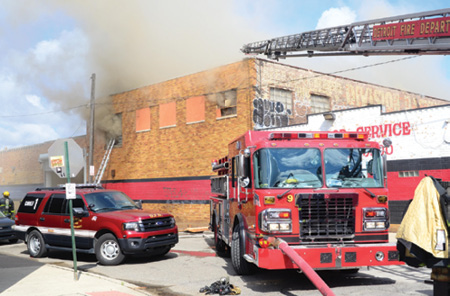
(1) Conditions were changing shortly after arrival as crews stretched and started to operate on the interior of the fire building. Note the aerial ladder positioned at the corner, allowing access to the A and D sides of the fire. (Photos by Dennis Walus.)
As Engine 1 and Engine 9 members stretched lines through the front of the structure, Squad 3 reported heavy fire in the rear; but with the amount of fire and smoke, sizing up the building was difficult. Firefighters encountered a second floor with modifications that was filled with heavy smoke and had zero visibility. Interior firefighters were not sure whether a stairway they encountered led to a third floor or to the roof. The stairway led to the roof, which had been permanently secured; there was no third floor/storage area.
Engine 9 firefighters, wearing full personal protective equipment (PPE), advanced two charged lines through the front bay door to the rear of the structure where heavy fire was reported. Engine 1 made entry with two additional charged hoselines from the rear, where personnel forced entry into the building using rotary saws and sledgehammers. As the fire progressed, billowing black toxic acrid smoke hampered the aggressive interior attack and search efforts. Chief 1, a 30-year veteran, called for two more companies, a rapid intervention crew, and additional staffing. Within minutes of that request, as the fire escalated and conditions rapidly deteriorated, Battalion Chief 6, a 31-year veteran, drawing on his institutional experience, bypassed calling the next greater alarm (a second) and requested a third alarm. The task was too great for the firefighters on the scene; they were taking a beating from the arduous work and the July heat.
Seniority, Experience, and Safety
Since 1860, Detroit’s seniority-based promotion system has kept firefighters safe and alive. At this incident, both chiefs on scene had responded to thousands of commercial fires and knew that adding an extra alarm to the initially dispatched commercial box alarm by requesting a third alarm would bring a senior chief (shift commander) and an additional battalion chief. Altogether, these chiefs represent a combined 125 years of Detroit “in the street” fire experience. In 2016, the DFD administration and the union created the commercial box alarm to be automatically dispatched to incidents involving multiunit apartment buildings, schools, hospitals, and warehouses. Getting personnel and equipment to a large incident on the initial response is just a safer way to operate; companies can always be sent back if not needed.
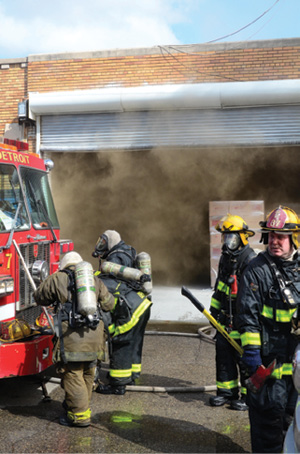
(2) Additional personnel arrive to assist interior crews. When crews are operating in enclosed structures, ensure that staffing is sufficient or request additional personnel. A large overhead rolling door provides an excellent opening for access to the fire and ventilation. At the upper left of the doorway, powerful torsion springs that counterbalance the door’s heavy weight assist the chain hoist mechanism. Heat attacking the torsion springs at the top of the doorway can cause them to lose their tension and the door may close unexpectedly, trapping firefighters in the building. Before making entry, it is very important to brace the door in the open position with a pike pole or other means.
Before all third-alarm companies arrived, an aggressive interior attack and search and rescue had been ongoing for 40 minutes. Chief 6 began pulling firefighters from the commercial warehouse, commanding, “Firefighters on the second floor, come out of the building.” Once the second-floor firefighters exited, all other firefighters were commanded to exit the building. The battalion chiefs on scene used institutional knowledge and timing to pull crews out in a safe, systematic, and organized manner so that no one would be left behind or lost in the structure. A frantic panicked withdrawal from a commercial building could delay the exit and result in a Mayday situation. Once Chief 6 confirmed that all firefighters had exited as ordered, he called for a defensive posture. Once all companies on scene acknowledged this change, the senior chief called for a personnel accountability report (PAR) of all companies on scene to confirm that no firefighters remained in the building.
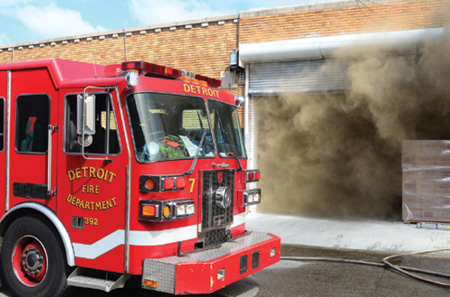
(3) Because of the change in interior first-floor smoke conditions, the IC requested additional companies. Compared to the conditions seen in photo 2, the smoke is getting lower and becoming more dense and turbulent, indicating deteriorating conditions.
As the flames and the blackish/gray smoke plume rose into the sunny Saturday morning sky, civilians approached the fire scene to watch firefighters as they controlled and contained the fire to the original warehouse, keeping it from damaging the four attached warehouses. The fire burned hard for almost five hours and required almost three hours of tower operations—hitting hot sports and cleanup including a small rekindle or two. Excavators were called in the next morning to remove the rubble.

(4) Interior firefighters exit the building after the IC issues the evacuation order and the operation transitions to defensive.
Altogether, eight engines, two ladder/platforms [one sent on mutual aid from the Hamtramck (MI) Fire Department], an additional ladder, three rescue squads, three battalion chiefs, one senior chief, one EMS/medic unit, and one EMS supervisor confined the fire to the structure of origin.
The DFD averages more than 250 incidents a day, including medical first responder runs, accidents, rescues, and the heaviest documented fire load in the fire service. In addition, DFD EMS responds to almost 450 runs every 24 hours.

(5) After the transition to defensive operations, firefighters on an exposure building roof prepare to operate from a point of advantage.
Commercial Construction
Commercial building fires in Detroit are always difficult to mitigate, control, and command for many reasons. Older buildings built in the late 19th/early 20th century may have undergone numerous modifications over the years; and, like most large buildings in cities, they can become traps for firefighters. Construction methods may include balloon frame, heavy timber, ordinary, and lightweight, which may all be interconnected and create open areas and avenues for fire to travel.
The firefighter’s credo, “Don’t leave your brothers, never drop the hoseline, and always stay close to and follow the hoseline in and out of the structure,” could not prove more valuable and relevant than in a twisting, turning multilevel occupied structure. Heavy fire and acrid smoke compel aggressive interior attack firefighters to use all senses and, most importantly, to maintain radio communication.
Experienced communication from chiefs with years of fireground experience to interior crews is paramount to firefighter safety. This profession is not a video game—it is real. Fire companies in Detroit consist of four personnel: one seniority-promoted officer, two firefighters, and a fire engine operator or a firefighter/driver who operates the apparatus and prepares tools and ground ladders for use on scene. The experienced boots on the ground have kept the country’s busiest firefighters safe.
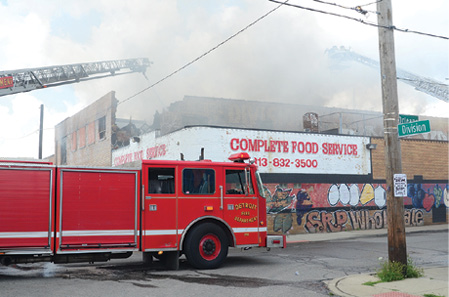
(6) The fire was contained to the original fire building (which collapsed) and did not extend into either exposure. Apparatus was positioned outside the potential collapse zone.
At this fire, Chief 6 called an immediate third alarm; eight engines, one truck, two platforms, three heavy rescue squads, three battalion chiefs, and the senior chief (citywide shift commander) responded. Getting personnel and equipment to the scene as soon as possible in a congested city area is a prime concern, especially when it is not reported or immediately known whether civilians are trapped. Companies can always be released if not needed. Staffing is also essential for ensuring an initial safe interior attack or in an unfortunate catastrophe involving fire.
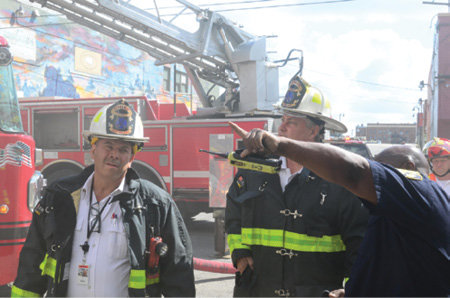
(7) The IC in a face-to-face discusses the firefight’s progress. He is also in constant communication with interior company officers and managing the incident and the safety of all on-scene members. Constant communication is essential throughout any size incident.
Detroit firefighters have learned in a rebounding/rebuilding city how to navigate through new construction attached to old construction. During the years of the city’s decline and decay, DFD firefighters have had plenty of practice in this and are passing on their learning and experience to the next generation of Detroit firefighters. The key to efficient, safe firefighting at this incident was fireground experience; clear calm communication; and, most of all, trust in the experienced senior officers and incident commanders.
MICHAEL NEVIN is a captain, a 30-year veteran of the Detroit (MI) Fire Department, and a second-generation Detroit firefighter.

